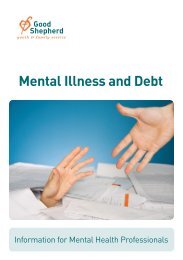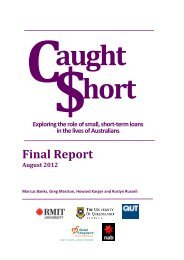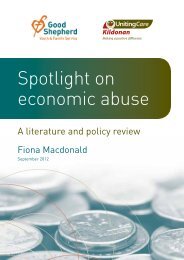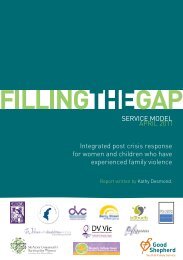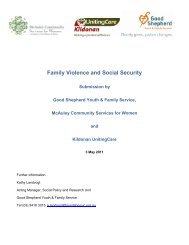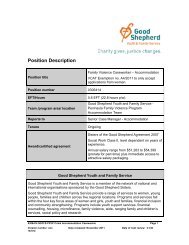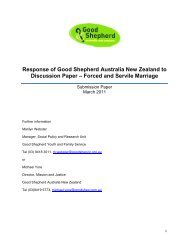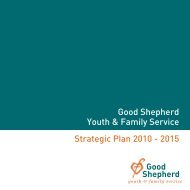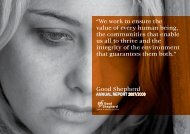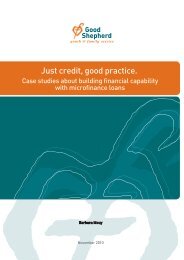Spotlight on economic abuse - Good Shepherd Youth & Family ...
Spotlight on economic abuse - Good Shepherd Youth & Family ...
Spotlight on economic abuse - Good Shepherd Youth & Family ...
Create successful ePaper yourself
Turn your PDF publications into a flip-book with our unique Google optimized e-Paper software.
Centrelink may seek to recover payments from her sp<strong>on</strong>sor who may be her ex-partner, a<br />
situati<strong>on</strong> which has been seen as placing the woman at increased risk of being subjected to<br />
further violence (Braaf & Barrett Meyering 2011).<br />
A crisis payment provided through Centrelink is equal to <strong>on</strong>e week of a standard benefit, and<br />
can be paid to people who experience severe financial hardship due to domestic violence<br />
and who are already receiving Centrelink income support payments. The payment can be<br />
made to people who have had to leave their home because of domestic or family violence or<br />
who remain in the home after a family member left or was removed due to domestic<br />
violence. However, women exiting violent relati<strong>on</strong>ships who are not eligible for Centrelink<br />
payments cannot access this payment.<br />
State governments also provide some crisis and hardship assistance and c<strong>on</strong>cessi<strong>on</strong>s for<br />
people <strong>on</strong> low incomes. For example, in Victoria there is an annual energy c<strong>on</strong>cessi<strong>on</strong> for<br />
low income households and a utility relief grant scheme to assist people in financial difficulty<br />
with gas, electricity or water bills. However, most of these types of assistance are <strong>on</strong>ly<br />
available to people who are eligible for a Health Care Card, thus excluding many women<br />
escaping domestic violence who may have assets ‘<strong>on</strong> paper’ but who actually have very<br />
limited immediate access to funds to pay for essential goods and services.<br />
Income management<br />
In 2007 the Howard Liberal-Nati<strong>on</strong>al Coaliti<strong>on</strong> Government introduced the income<br />
management scheme under which a proporti<strong>on</strong> of a pers<strong>on</strong>’s income support payments are<br />
‘quarantined’ or able <strong>on</strong>ly to be spent <strong>on</strong> certain goods and services (for example, health<br />
care, housing, food, clothing, educati<strong>on</strong>). While initially introduced as a compulsory scheme<br />
in some Aboriginal communities in the Northern Territory and as part of a trial in Cape York,<br />
provisi<strong>on</strong>s were also made for voluntary income management. The Labor Government has<br />
maintained and extended the scheme and from July 2012 it will operate throughout the<br />
Northern Territory and in five new locati<strong>on</strong>s, which are the local government areas of<br />
Sheppart<strong>on</strong> (Victoria), Bankstown (New South Wales), Rockhampt<strong>on</strong> (Queensland),<br />
Playford (South Australia) and Logan (Queensland). The income management scheme<br />
utilises a ‘BasicsCard’ which a pers<strong>on</strong> can use to purchase goods and services from<br />
approved businesses while there are restricti<strong>on</strong>s <strong>on</strong> funds being spent <strong>on</strong> alcohol, tobacco,<br />
pornographic material and gambling products. Other features of the scheme include<br />
matched savings plans, m<strong>on</strong>ey management services and training, financial counselling and,<br />
in the case of voluntary participants, financial incentives for staying in the scheme<br />
(Buckmaster & Ey 2012).<br />
Income support payment recipients who may be put <strong>on</strong>to the income management scheme<br />
are people who are referred by state or territory child protecti<strong>on</strong> authorities where children<br />
are deemed to be neglected or at risk, people assessed by Centrelink social workers as<br />
being ‘vulnerable’ and people who volunteer for income management. Indicators of<br />
vulnerability are financial hardship, financial exploitati<strong>on</strong>, failure to undertake reas<strong>on</strong>able<br />
self-care and homelessness or risk of homelessness. Financial exploitati<strong>on</strong> is described as<br />
occurring “when a pers<strong>on</strong> is subject to undue pressure, harassment, violence, <strong>abuse</strong>,<br />
decepti<strong>on</strong> or exploitati<strong>on</strong> for resources by another pers<strong>on</strong> or people, including other family<br />
members and community members” (Department of Families, Housing, Community Services<br />
and Indigenous Affairs [FaHCSIA] 2012, secti<strong>on</strong> 11.4.2.20). Thus, people who are subjected<br />
to ec<strong>on</strong>omic <strong>abuse</strong> are specifically identified as targets for income management.<br />
The stated objectives of the income management scheme include to reduce hardship and<br />
deprivati<strong>on</strong>, to help people to budget, to reduce discreti<strong>on</strong>ary spending <strong>on</strong> restricted items, to<br />
reduce the likelihood of people being subject to harassment and <strong>abuse</strong> in relati<strong>on</strong> to their<br />
30



